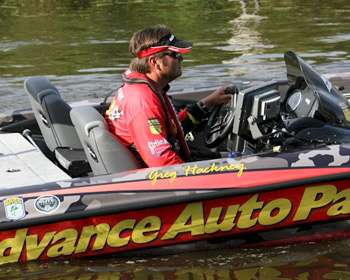
It might be one of the first bass fishing axioms an angler learns: "Where there's grass, there's bass." Unfortunately, as Elite Series pro Greg Hackney points out, not all grass mats are created equal.
In fact, if you're not fishing the most productive areas of a particular mat, you might as well be throwing rocks. Whether it is milfoil, hyacinth or hydrilla, a universal truth exists — it all looks good and it all looks like it should hold bass.
The fact is that bass anglers often get discouraged when trying to decipher where bass will be hiding amid a labyrinth of matted vegetation. The biggest key in pinpointing productive grass is finding the bait," Hackney points out. "You can go to lakes in some parts of the country where it's all one big grassbed, and it just blows people's minds. They think it all looks exactly the same; they can't even start to figure out where to begin."
At this point, many anglers throw in the towel when trying to pinpoint a grass bite. Instead of taking a little time to decipher the clues that nature provides, many of us simply pull up to the edge of a grassline and just start casting. Hackney reveals that in order to be successful at fishing grass, you have to be keenly aware of your surroundings. "The first thing I always do when trying to find the most productive areas of a grassbed is look for bait activity — either minnows, or shad flipping around.
If there's a lot of matted grass, I'll listen for bream popping," he says. "If it's the heat of the summer, grass along the river channel will normally be more productive," he says. "During the spring, though, I'm going to move farther back into spawning coves because the fish should be moving up shallow to spawn. Again, I always try to follow the bait."
Flipping mats in the heat of the summer is one of Hackney's preferred patterns, and he has discovered a key to identifying hot spots within these mats at this time of the year. "On certain lakes where you have a lot of milfoil in the summertime, an algae mat will form," he reveals. "Underneath that algae mat, fish will congregate because the water is usually a little cooler than it is under grass without the algae." Likewise, on lakes where hydrilla is the primary form of vegetation, Hackney explains that new growth is the key to success, though it's often overlooked.
"You'll have a definite mat line of new grass wherever hydrilla is present," he says. "As the water starts to fall in the summertime the grassline begins to grow in deeper water, tapering down from the visible grass edge. Most everyone will key on the grass that you can see, but the bass prefer to follow that 'new' grass below, which you can only locate with your depthfinder."
Looking across a lake covered in matted vegetation can certainly be intimidating; however, Hackney points out that by cluing in to the various features that each mat provides, a pattern can quickly emerge. "More times than not, if I find bait around the mat, I'll find fish." he says.
"It might not be the mother lode, but it will be enough to show me a pattern I can follow."
(Provided by Z3 Media)




